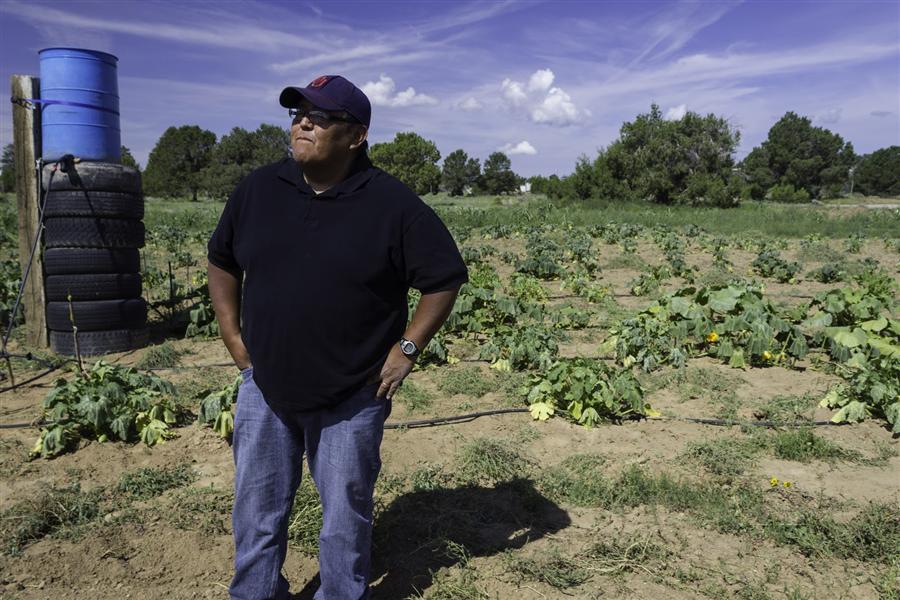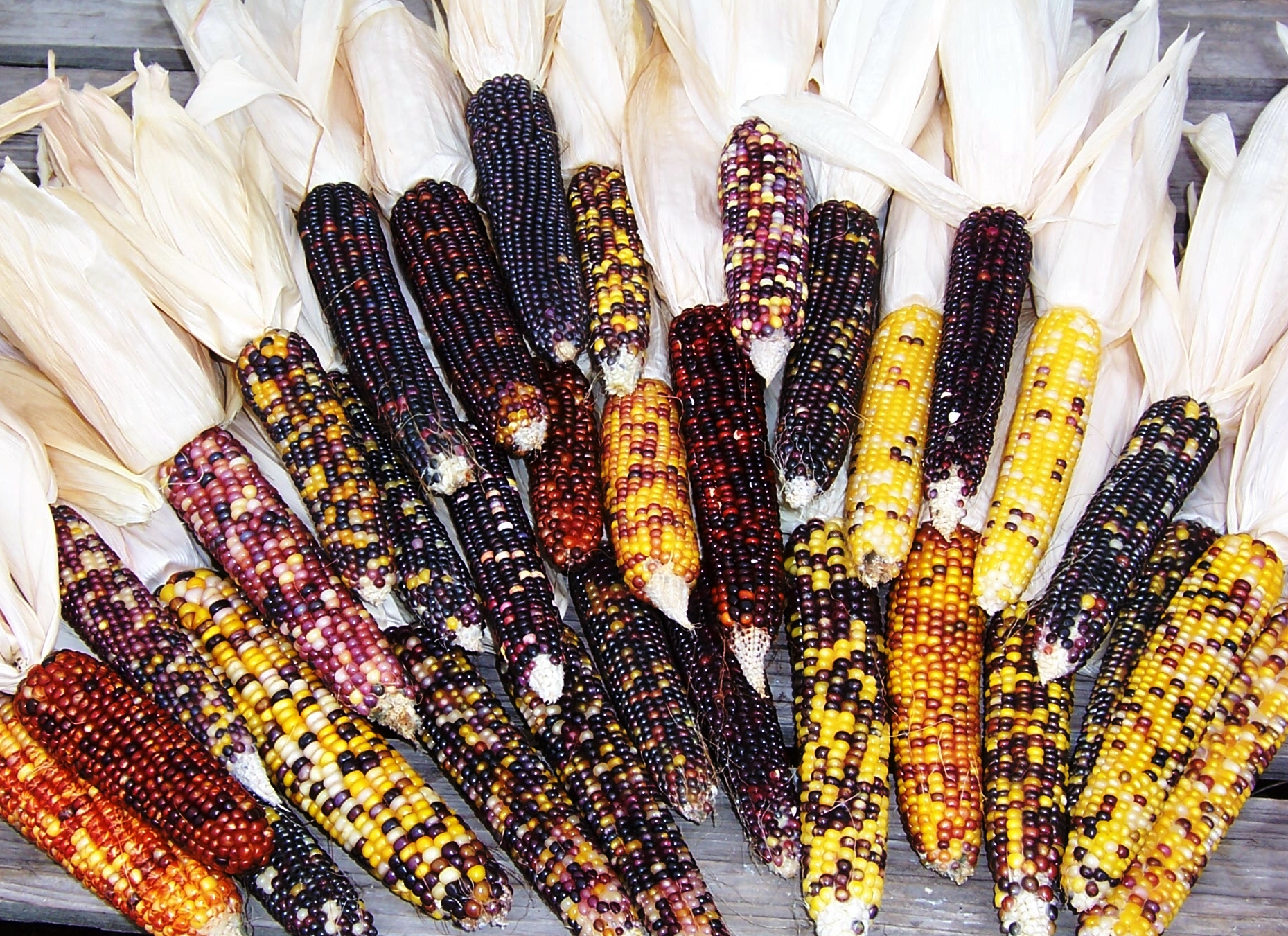Evolution of Navajo Food Systems
Amanda Burleson
Introduction
Many health Issues plague the Navajo Nation, especially those that can directly be related to diet, including obesity, diabetes, cancer and cardio-vascular disease. The Navajo Nation, or as they call themselves, the Dine’, are combating these contemporary challenges in innovative ways that are at the same time re-connecting them with their Native American heritage.

Demographics
The Navajo Nation has the largest land base of all the American Indian Reservations in the United States consisting of 27, 425 square miles of land. It exists in three states, Arizona, New Mexico and Utah. There are over 300,000 thousand enrolled tribal members; of those 173,667 are currently living on the reservation. Most of the current health problems affecting the Navajo people are related to socio-economic status and social behavior.(1)
Food Security is the ready availability of nutritionally adequate and safe food. Native Americans have twice the rate of food insecurity than the general United States Population. Food insecurity has a direct relationship to produce intake and health status. Diabetes is a particular concern among the Navajo as more than 40 percent of the Navajo people 40 yeaers and older have diabetes. There has also been an alarming increase in the rate of adolescents with diabetes, 106 percent increase between 1990 and 2001.(4)
Traditional Relationships with Food

The relationships that the Navajo have with food can be traced back to their creation beliefs. Tradition says that plants predated human beings and that the Navajo were created from corn which is considered a sacred plant.To the Navajo, all plants and animals are seen as life-beings. Traditional teachings show that they occupy an important place in Navajo spirituality. Food is also serves very important roles in prayer and healing. The corn plant is used in many different ways in ceremonies, prayer, and offerings. Plants such as corn, beans, squash and tobacco are seen as important to mental, emotional spiritual and physical well-being.(1)
Today’s Navajo diet is completely different. One survey indicated that the majority of Navajo were consuming less that one serving of fruit or vegetables per day (4). The common diet consumed on the reservation is very high in fat sugar and salt. “Adoptions of foods such as eggs, bacon and potato’s from main stream America” and the “fast foods and ready-made foods,” are believed to be directly correlated with negative health effects such as diabetes, obesity, and high blood pressure. A shift in the types of food and the difference in portion sizes are main concerns among Elders of the Navajo Nation. They also say that, “in the past people were aware of the teachings and origins of the historically consumed traditional foods, today there is a general lack of awareness of what is being consumed.” “ When a person raises crops or livestock they know what goes into that food source, and where it is coming from. In the modern Diné Diet, many items purchased at grocery stores are shipped long distances and are loaded with ingredients that are difficult to identify.”The Elders also express their concerns in the shift not only in the types of foods being consumed, but also in the practices concerning portion sizes. They are worried about the change from eating “just what you need” to the main stream American idea of “ all you can eat.”(1)
Brief History of Navajo and food systems
The declining health within the Navajo Nation is believed by many Elders to coincide with the loss of connection to Navajo culture, food systems, family and community. The food system was first believed to be disrupted when the Spanish appeared in the southwest. They brought many foods that were adopted by the Navajo including peaches, apples, melons wheat and most importantly Churro sheep. Sheep herding became inseparable from the Navajo way of life.(1)
During the 1800’s the United States Government carried out aggressive and violent western expansion under the belief of “Manifest Destiny.” The United States engaged in the Mexican-American war and as a result claimed the land that was then occupied by the Navajo people. From about 1851 until a treaty was formed in 1868 a number of brutal tactics were employed to try to remove the Navajo including shooting people on site, scorched earth tactics, slaughtering of livestock and destruction of water sources. The Navajo were effectively starved out and were forced to go to the Military forts for food rations. When the people came for food they were then forced to be captives and were not allowed to return to their lands. (1)
In 1863 Forced marches had begun in an effort to remove the Navajo from their lands. They were marched to Fort Sumner where many died from the conditions and starvation. The Navajo were forced at this time to become dependent on the U.S Military to feed them and provide for them.(1) In 1868 a treaty was formed and the Navajo people were allowed to return to their land. Much of their homes and agriculture had been destroyed and as a result part of the treaty included a commitment from the U.S. Government to provide food distribution. At this time the U.S. Government also gained authority over the agricultural use of the land and the distribution of livestock. The Navajo became very proficient in the manufacture of wool products, especially blankets. This became a significant way for many to provide a wage for themselves.(1)
In the decades following exposure to non-Navajo foods continued to increase. Many Navajo lost the means to provide for themselves and became more dependent on a wage-based economy. Families became less able to provide food for themselves and became more dependent on the U.S. Government.(1) By the 1980’s sweetened drinks, soda, store bought bread and milk were common place in most households, along with Navajo staple foods such as fry bread, tortillas, potato’s and mutton.In this way the Navajo Nation became more dependent on gaining their food from the outside world rather that growing or providing their own.
Food Desert
A Food Desert is an area that does not have access to affordable and healthy foods. The USDA defines this as regions that have low income, little vehicle access and the closest grocery store is over 20 miles away. With the Navajo nation there are only 10 grocery stores, leaving many people to drive over 150 miles just to buy groceries.(citationfoodsov) In fact most communities are served by a trading post, convenience store or gas station that only provide highly processed, canned or dry foods.(2)
Reconnecting with Tradition
Research has demonstrated that though there is lack of access to healthy food, there is an overwhelming interest among the Navajo in learning about traditional foods. While this is true, many feel that there is a lack of access to information and education on traditional foods.(2) The Elders are the key knowledge holders and in order to begin to return to a nation that provides its own food it is suggested that mining them for knowledge would be a great place to start. Reconnecting families and youth with the traditional ways that connect them with the land is a good start. One idea that is catching on is the promoting of self-sufficiency through community gardening. Gardens are now being seen as a source of health and well-being as well as a return to a healthy way of life. Respect for Elders and intergenerational knowledge transfer is way of connecting youth with their Elders and learning to garden. Successful garden based interventions need to address the community needs and actively involve participants. Emphasizing visual learning, methods, Navajo traditions and storytelling also add value.(2)
Conclusion
Awareness of the connection between healthy food and tradition seems to be an important way for the Navajo to begin to regain control not only of their health but also of their heritage. Many projects are being sponsored across the Navajo Nation, including school and community gardens that are accessing the knowledge stored by the Elders and once again being embraced by the people. There is much work to do but it shows that sometimes by turning back toward tradition the Navajo can look forward to better health.
Citations
- Dine’ Policy Institute.2014. Dine’ Food Sovereignty:. A Report on the Navajo Nation Food System and the Case to Rebuild a Self-Sufficient Food System for the Diné People
- Lombard, kevin A, Shirley A Beresford, India J Ornelas, et al. 2014 Healthy Gardens/Healthy Lives: Navajo Perceptions Of Growing Food Locally to Prevent Diabetes and Cancer. Health Promotion Practice 15(2): 223–231
- Pardilla, Marla, Prasad, Divya, Suratkar, Sonali, et al. 2013 High levels of household food insecurity on the Navajo Nation.Public Health Nutrition 17(1),58-65
- Ray, Emma Bah, Holben, David H., Holcomb, John P.2012 Food Security Status and Produce intake Behaviours, Health Status, and Diabetes Risk among Women with Children Living on a Navajo Reservation. Journal of Hunger and Environmental Nutrition.7(1):91-100
- Setala, Ashley, Gittelshohn, Joel, Speakman, Kristen, et al.2011 Linking Farmers to Community Stores to increase consumption of local produce: a case study of the Navajo Nation.Public Health Nutrition. 14(9),1658-1662